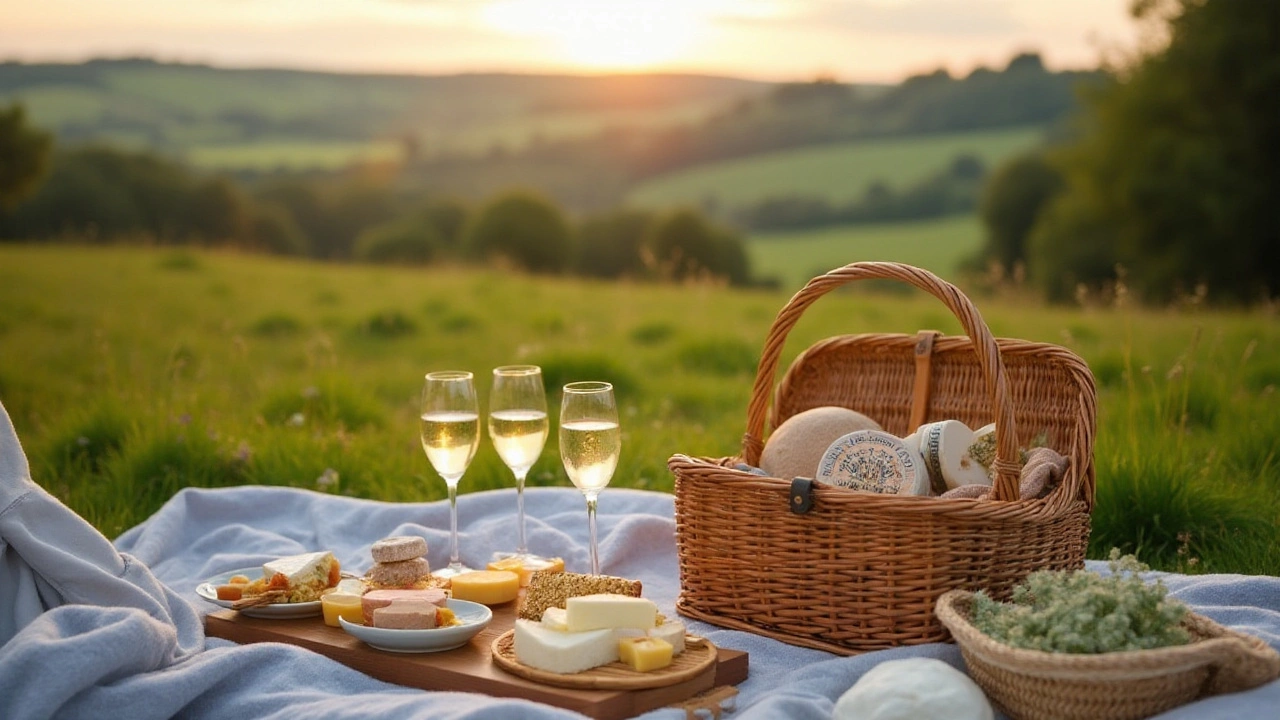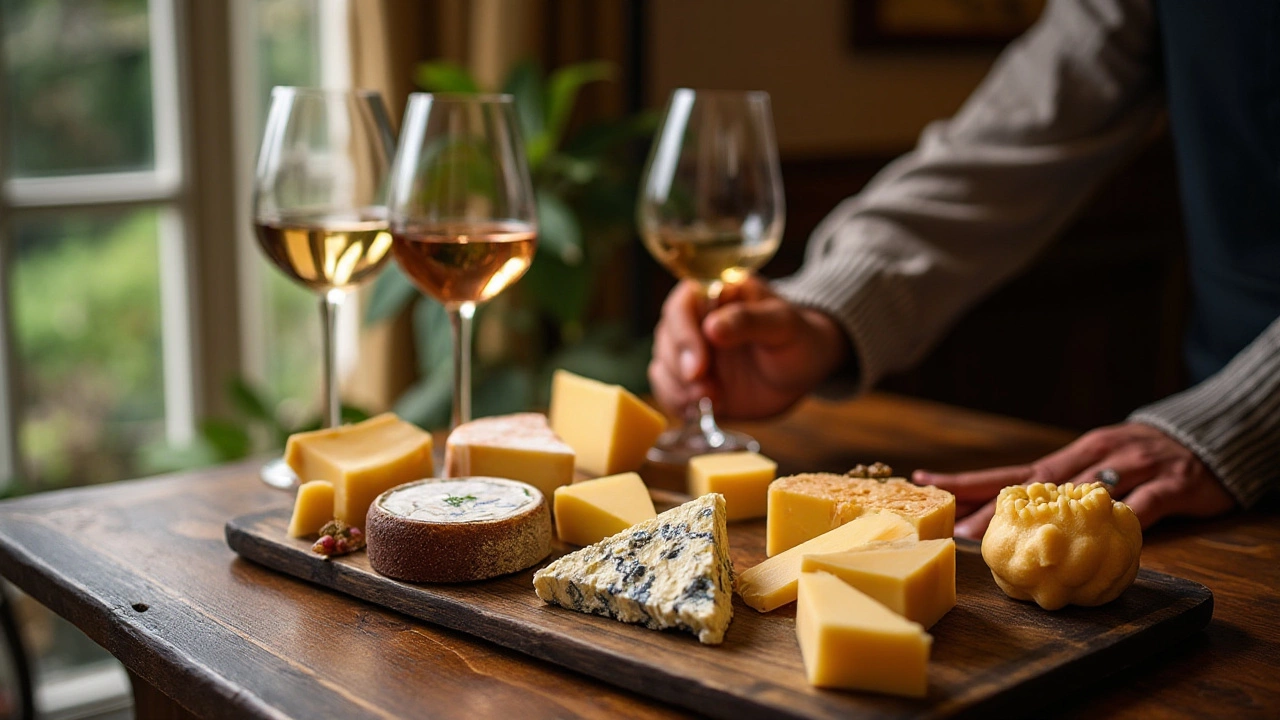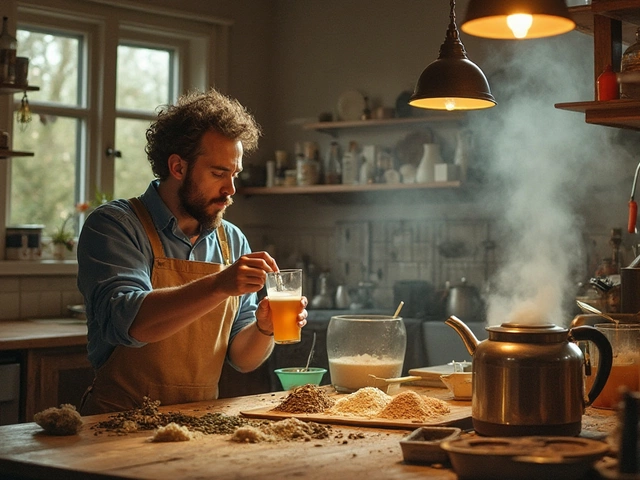Pairing wine with cheese is an art that has delighted the senses of gourmets across the world for centuries. The union of rich, savory cheese with the complex notes of wine can elevate any gathering from ordinary to extraordinary.
Understanding the basics is key to mastering this delightful skill. A well-thought-out pairing enhances the flavors of both the wine and the cheese, creating a symphony of taste that dances on your palate. It's about more than just matching white wine with mild cheese or red wine with aged varieties; it's about understanding and playing with textures, contrasts, and complements.
Embark on this flavorful journey with confidence, armed with knowledge and curiosity. Whether you're preparing a sophisticated dinner party or a casual get-together, these tips will help you offer an unforgettable wine and cheese experience that delights all your senses.
- Understanding Flavor Profiles
- Classic Pairings and Why They Work
- Experimenting with Unusual Combinations
- Tips for a Successful Wine and Cheese Night
- Common Mistakes to Avoid
Understanding Flavor Profiles
Diving into the intricacies of wine and cheese pairing begins with a keen sense of recognizing and appreciating diverse flavor profiles. Every cheese has a unique spectrum of flavors, from mild and creamy to sharp and pungent, echoing its origin, ingredients, and aging process. Similarly, wines span an array of taste dimensions, including fruity, spicy, earthy, and floral notes. The journey of pairing these flavors is akin to orchestrating a beautiful symphony where each taste note harmonizes to create a cohesive culinary experience. To fully engage the palate, it's essential to consider factors like acidity, sweetness, and tannins in both the cheese and its wine counterpart. A creamy Brie, with its buttery, nutty profile, might perfectly balance the crisp and citrusy notes of a Chardonnay, whereas an aged cheddar’s bold undertones could match the robust and tannic character of a Cabernet Sauvignon.
Equally important is understanding how texture plays a role in flavor profiles. The creaminess of a soft cheese or the crystalline texture of a hard, aged cheese contributes significantly to its flavor perception. Wine, with its varied mouthfeel—ranging from the luscious, silky essence of a Merlot to the vibrant sparkle of a Champagne—can highlight or balance these textures beautifully. As you embark on this pairing exploration, remember: the goal is to strike a pleasing balance where neither the wine nor the cheese overwhelms the other. Some pairings are traditional, yes, but venturing into uncharted territory with combinations that might seem peculiar at first is part of the adventure. Echoing the words of wine expert, Hugh Johnson,
"Wine is a living thing, and the way it expresses its character depends significantly on the context of the meal."
Recognizing and mapping flavor profiles involve a bit of experimentation and learning from each experience. As you try different combinations, pay attention to which pairings elevate the flavors and which might clash. Some might find that the sweetness of a dessert wine like Sauternes harmonizes splendidly with the saltiness of Roquefort cheese, highlighting a delightful contrast. Others might prefer complementary pairings, like the herbal undertones of a Sauvignon Blanc with a goat cheese from the Loire Valley. The art is in the discovery and the newfound appreciation for the nuances of taste each time you indulge in wine and cheese. And as you refine your understanding of pairing wines with cheese, you'll not only enhance your palate but also gain insightful stories and experiences to share at your next gathering around the cheese board.
Classic Pairings and Why They Work
When you think of traditional wine and cheese pairing, some combinations immediately come to mind, like the timeless duo of Cabernet Sauvignon with aged cheddar or the delightful union of a sweet port with a strong blue cheese. These combinations are classics for a reason. They have been tested through time and tastings, emerging victorious as pairs that highlight and complement each other’s best features. Take for example the pairing of Brie with Chardonnay. This works so beautifully because both share buttery characteristics that marry well on the palate. The creamy texture of Brie is accentuated by Chardonnay’s lush body, creating a rich, seamless taste experience.
A less-known but equally effective classic is the combination of Sauvignon Blanc with goat cheese. Here, the high acidity and crispness of the wine flatters the tart and tangy profile of the cheese. This pairing is a symphony of balance; the wine cuts through the richness of the cheese, yet neither flavors overpower the other. The layers of a Riesling paired with an aged Gouda also deserve a spotlight. The sweetness and slight petroleum notes of Riesling bring out the nuttiness and caramel notes in Gouda, creating an unforgettable taste fusion characteristic of pairing wines with cheese.
There is a great wisdom in classics that often eludes us. The harmony found in a pairing like Roquefort and Sauternes reflects not just the science of taste but the history of culture. An age-old French tradition, this duo balances the crumbly, rich, salty notes of Roquefort with the luscious, sweet, and honeyed notes of Sauternes, demonstrating how opposite flavors sometimes attract in the culinary world. Food critics and sommeliers alike often reiterate this.
"Wine and cheese have the power to create a taste greater than the sum of their parts," says Anthonia, a renowned sommelier. This is the joy and magic of classic pairings — they work by enhancing the natural flavors of each ingredient, creating a new pleasurable sensation.
These tried-and-true pairings often guide newcomers to this pastime. Some enthusiasts might prefer to begin their journey here, examining why these classic pairings have stood the test of time. A chart showcasing some of these classic pairings might aid in better understanding them:
| Wine | Cheese |
|---|---|
| Cabernet Sauvignon | Cheddar |
| Brie | Chardonnay |
| Sauvignon Blanc | Goat Cheese |
| Riesling | Aged Gouda |
| Sauternes | Roquefort |
So, whether you're at the beginning of your journey or a seasoned expert exploring rediscoveries, these pairings offer an insight into why they remain beloved. Using these combinations as a guide can encourage curiosity and offer a base from which to experiment with cheese and wine tips that are more adventurous.

Experimenting with Unusual Combinations
In the vast world of wine and cheese pairing, the thrill of discovery often lies in departing from the expected. Sure, the classic pairings have stood the test of time, but there's magic in venturing into uncharted territory. This journey invites your senses to experience new flavors and textures, challenging the conventional to create something truly memorable.
Imagine pairing a sharp blue cheese with a sweet dessert wine. The salty bite of the cheese, when met with the delicate sweetness of the wine, creates an unexpectedly delightful dance. This kind of pairing revolves around the idea of contrast, where one element brings out the best in the other through its opposition. Bold reds aren't exclusive to the domain of hard aged cheeses; they can complement the creamy, nutty flavors of a good gouda in ways that surprise and satisfy.
Getting adventurous doesn't mean you need to be a sommelier or a cheese connoisseur. It starts with understanding that pairing wines with cheese is as much about intuition as it is about knowledge. Exploring the intersection of sensation means thinking about flavors from different perspectives. Consider the earthy notes in an oaked Chardonnay complementing a truffle-infused cheese, enhancing the mushroomy undertones with its slight vanilla backdrop.
"To take a 'round-the-world tour with your taste buds, match a smoky Spanish Manchego with a well-rounded Syrah. The firm, nutty profile of Manchego finds a surprising partner in the fruity, peppery notes of the Syrah," advises renowned sommelier Lucy Stevens.
Finding joy in the unexpected blends is not about upending traditions but allowing them to inspire your own creativity. Sometimes the most unusual pairings stem from cultural histories. For example, Japanese sake can harmonize beautifully with creamy Brie, combining silky textures with a subtle sweetness that respects yet reinvents classic ideas.
There's a rising trend of famous chefs and food enthusiasts alike who focus on these unconventional pairings. They remind us that both cheese and wine tips are evolving as part of our ever-changing palates. Some adventurous souls have paired spicy jalapeño-infused cheeses with the effervescence of a bright Prosecco, finding that the bubbles heighten the heat while cooling the palate just enough.
As you step into the exhilarating world of unusual pairings, keep in mind that it's all about personal preference. What might seem unconventional to one might be a treasured combination to another. Embrace the journey, delight in the discovery, and let each pairing tell its own unique story. This, perhaps, is the true essence of enjoyment in wine and cheese.
Tips for a Successful Wine and Cheese Night
Throwing a wine and cheese night can be a delightful way to entertain friends and family while exploring the complexities of flavors. To ensure your evening is a hit, focus on creating a harmonious atmosphere where guests can savor the exceptional pairs you've selected. Start by picking a variety of wines and cheeses that cater to a range of tastes. Having a balanced assortment means including both milder and more robust flavors. For instance, a light, crisp white wine might complement a soft cheese, while a bold red could harmonize with aged cheese, like a mature cheddar or gouda.
Presentation plays a significant role in enhancing the experience. Arrange your cheeses on a large wooden board, colorfully complemented by fresh fruits, nuts, and assorted crackers. Ensure that each cheese is clearly labeled to guide your guests on their tasting journey. While it might be tempting to serve an overwhelming amount, balance is key; smaller, carefully curated selections often lead to more meaningful food conversations.
When it comes to serving wine, consider using a different glass for each type to fully appreciate the unique aromas and flavors. Place tasting cards next to each selection, offering brief descriptions of origin and tasting notes. This not only educates your guests but also encourages them to savor and discuss what they're experiencing. A successful night is as much about learning as it is about enjoyment.
If you wish to dig deeper into pairing mastery, don’t hesitate to extend your research.
Cited by renowned sommelier Karen MacNeil in her book 'The Wine Bible,' she states, "Pairing is not simply an art, but the joyful flirtation between two sensory experiences." A statement that perfectly encapsulates why this age-old tradition captivates so many.
Creating interaction points can elevate the evening's charm. Consider organizing a small blind tasting game, encouraging guests to guess the wine based on taste and aroma without seeing the label. Such activities can spark lively discussion and make your wine and cheese night memorable. And remember, the aim is pleasure, so remind everyone to relax, relish, and repeat as often as their schedules or waistlines permit!

Common Mistakes to Avoid
Diving into the delicious world of wine and cheese pairing can sometimes lead to missteps that could dampen the experience. One common mistake is serving cheese at refrigerator temperature. Cheese tastes best at room temperature, where its full flavors and textures can blossom. Cold cheese can often mask the more subtle nuances that make it special, and pairing it with wine at mismatched temperatures could lead to clashing flavors. Letting the cheese sit out for about an hour before consumption will dramatically improve the tasting experience.
An often overlooked error is improper cheese selection. Not all cheeses are created equal, and not every wine will marry well with every cheese. A crucial component of pairing wines with cheese is understanding the characteristics of each. Creamy cheeses might drown in the bold tannins of a heavy red wine, whereas a sharp blue might overpower a delicate white. It's important to balance strength with strength and delicacy with delicacy, ensuring that neither the wine nor the cheese overshadows the other in flavor.
Then there's the issue of overloading the palate, which is more common than one might think. Offering too many varieties of both wines and cheeses can confuse the taste buds and muddle the experience. Instead, focus on a curated selection that allows each element to shine. Incorporate a range of textures and flavors — from a mild brie to a robust aged cheddar — but keep the options manageable to maintain clarity in tasting.
Another frequent mistake is neglecting to cleanse the palate between tastings. Without a neutral buffer, cheese flavors can linger and muddle your ability to enjoy the subsequent wine. A simple bite of bread or a sip of water can refresh the senses and ready the palate for the next sensation. As noted by cheese expert Janet Fletcher, "The key to a memorable pairing is to have a clear taste of both the wine and the cheese," which highlights the importance of a clean slate between pairings.
Lastly, failing to tell the story behind each cheese and wine can turn a potentially enlightening experience into just another snack outing. Both wine and cheese have rich histories and unique characteristics that are enhanced by context. When guests understand why a particular pairing was chosen and the background of each component, it deepens appreciation and heightens the experience. Cheese and wine tips are not just about the pairing—they're also about sharing the journey these foods and beverages took to arrive at your table.


